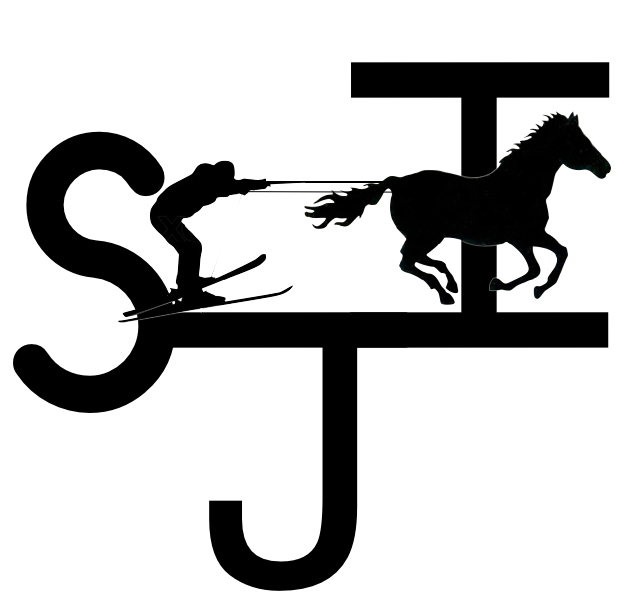HORSES
Equine skijoring is believed to have made its official debut in Stockholm at the Winter Games of 1901. In 1924, skijoring was demonstrated at the Winter Olympic Games in Chamonix, France and in 1928, skijoring was featured as an exhibition sport at the Winter Olympics in St. Moritz, Switzerland.
Today, in Europe, equine skijoring remains popular as a recreational activity in ski resorts around Chamonix and is also a tradition during White Turf, an event held annually in Saint Moritz since 1907 which features horse racing on snow as well as chariot racing and equine skijoring.
Equine skijoring found its way to the United States at the turn of the 20th century when American tourists returned from their travels in the Alps. As early as 1914, the sport was enjoyed on a recreational level at the resort on Mirror Lake in Lake Placid, New York and on a competitive level at the Dartmouth Winter Carnival in Hanover, New Hampshire as well as at Steamboat Springs’ Winter Carnival. Racing down snowy main streets with horses running side by side took place in towns like Jackson, WY and Aspen, CO in the 1930s and 1950s.
Leadville, Colorado introduced the concept of setting an obstacle course for the skier with gates, jumps and rings and has been hosting a competition down its main street since 1949. Today, races are held in Montana, Idaho, Wyoming, Colorado, Utah, Maine, Wisconsin, Minnesota, Washington, and Alberta, Canada.
saint moritz, switzerland
The Engine Valley of Switzerland, and more specifically, Sankt Moritz (Saint Moritz spelled in Swiss German), holds claim to being the birthplace of equine skijoring in its purest form when it comes to racing. This is hard to dispute. After all, it was here that "almost 100 years ago, a couple of enterprising sports enthusiasts invented a brand new equestrian pastime", the sport of skijoring, and it even "flirted with the idea of becoming an Olympic discipline", according to the White Turf website. "Nowhere else in the world do thoroughbred horses regularly compete without riders on their backs but instead with skiers in tow."
So since 1907, for three consecutive Sundays every February over 35,000 spectators gather on the frozen lake of Saint Moritz to view this amazing spectacle. White Turf features international thoroughbred horse racing with jockeys, modern chariot racing and skijoring competitions.
Under a white tented village built on the frozen lake with the pristine Alps serving as a spectacular backdrop, spectators from all over the world sip on champagne, place bets on the races, and mingle while listening to music.
The next event will be held February 8, 15 & 22, 2026.
For more information, click on www.WhiteTurf.ch
zakopane, poland
Every year in the Tatra Mountains of Poland, a tradition unfolds that marks the end of the Highlanders' Festival known as the Goralski Karnawal. The race is called the kumoterska gonba, more commonly known as "Kumoterki", and involves riders, two on every sledge, pulled by horses. There are also skijoring races.
The name comes from the small type of sledge used from the past until now to transport godparents for religious occasions in the area of Podhale. There is also a parade called the Parada Gazdowska. Over 30 horses take part in Gazdowska and Kumoterska parades. In different races, like kumoterki race skjoring and skiskjoring races, there were 24 participants and about 20 horses. The region is deeply traditional, patriotic and Catholic so the residents present themselves and their horses with traditional clothes, accessories and shiny brass ornaments.
The 2026 events will be announced. They typically run from late January - February. Sadly, for the past two years, lack of snow and warm temperatures have caused cancellations. For the latest news click here: https://www.facebook.com/KumoterkiPL
Bialy Dunajec
Poronin
Ludzmierz
Bukowina Tatrzanska
Kościelisko
Zakopane
UNITED STATES OF AMERICA
It can be proven that recreational skijoring came to Lake Placid, New York and competitive racing to Dartmouth College in Hanover, New Hampshire as early as 1914-1915. Steamboat Springs, CO began their winter carnival in 1914 as well, and local historians insist that skijoring was included from the start. There is strong evidence in photographs and postcards that skijoring races also occurred down main streets in Jackson Hole, Wyoming in the 1930's and in Aspen, CO in the 1950’s.
Leadville, Colorado is the birthplace of skijoring races as we know them in the United States today. In 1949, Leadville organizers began setting an obstacle course for the skier with gates, jumps and rings.
Presently, an equine skijoring race circuit exists throughout the Rocky Mountain region stretching as far south as the San Juan Mountains of Colorado and as far north as Alberta, Canada. True to the renegade tradition of the sport, all races are independent of any sanctioning body.
However, Skijor USA serves as a unifying body and promotes the sport world wide. All races uphold stringent safely, fairness and sportsmanship standards and while setting their own courses.
Skijor USA and Skijor International are working to honor the 100th anniversary of skijoring in the Winter Olympics in Chamonix, France and Salt Lake City, Utah in 2030 or 2034 respectively by including it as an exhibition sport or as part of the torch relay or opening ceremony.
For more information, click on www.SkijorUSA.com

























